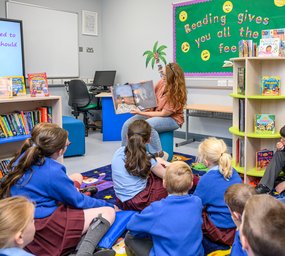
This report is based on responses to our Annual Literacy Survey, with a focus on responses from 5,156 children and young people aged 8 to 18 attending 48 schools across Northern Ireland. It includes findings on reading enjoyment, frequency and motivation and explores responses by background characteristics such as age, gender and socio-economic background.
Key findings
Reading enjoyment:
In 2025, reading enjoyment levels in Northern Ireland were low, particularly among boys, young people aged 11 to 16 and those who received free school meals (FSMs).
- Fewer than 3 in 10 (28.9%) children and young people aged 8 to 18 said they enjoyed reading in their free time, meaning 7 in 10 (71.1%) did not enjoy reading.
- More girls than boys said they enjoyed reading (34.6% vs 23.4%). Reading enjoyment was highest in 8 to 11s, However, levels decreased sharply for 11 to 14s and 14 to 16s, before increasing again slightly in 16 to 18s.
- More children and young people who did not, than who did, receive FSMs said they enjoyed reading (30.6% vs 23.7%).
Reading frequency:
Fewer boys, older age groups and those receiving FSMs reported reading daily compared with girls, primary-aged children and those who did not receive FSMs.
- Only 1 in 6 (16.9%) children and young people aged 8 to 18 in Northern Ireland said they read daily or almost daily in their free time in 2025, while 1 in 3 (28.7%) told us that they rarely or never read.
- Almost twice as many girls as boys reported reading daily (20.9% vs 12.9%). As with reading enjoyment, more 8 to 11s reported reading daily compared with other age groups. For example, while 34.7% of 8 to 11s read daily, just 13.5% of 11 to 14s did so.
- Almost twice as many children and young people who did not receive FSMs read daily (19.1%) compared with those who receive FSMs (11.5%).
What motivated children and young people to read?
While levels of reading enjoyment and frequency were quite low, many children and young people still found value in reading, particularly for learning and wellbeing.
- For example, nearly 3 in 5 read to learn new words (56.7%) or new things (56.4%), 3 in 5 (59.9%) read to feel relaxed and more than 2 in 5 (44.4%) read for escapism. In addition, 1 in 4 (24.8%) read to learn more about issues and causes they cared about.
In terms of what would make them read more:
- More than 1 in 2 children and young people said finding books that matched their hobbies and interests (50.6%) and material related to a favourite film or TV series (49.0%) made them want to read. 2 in 5 (43.4%) were drawn in by an interesting book cover or title or by having the freedom to choose what to read (39.4%).
While the report notes low levels of reading enjoyment and frequency in children and young people in Northern Ireland in 2025, it also shows that many children recognise the benefits of reading for learning, wellbeing, and social connection, and the importance of promoting relevance and autonomy for engagement.
The National Literacy Trust’s Libraries for Primaries programme, active in 33 schools in Northern Ireland and expanding to 73 by the end of 2025, aims to foster a culture of reading for pleasure by providing inclusive, interest-driven resources and environments, contributing to improved literacy, academic success, and mental wellbeing.